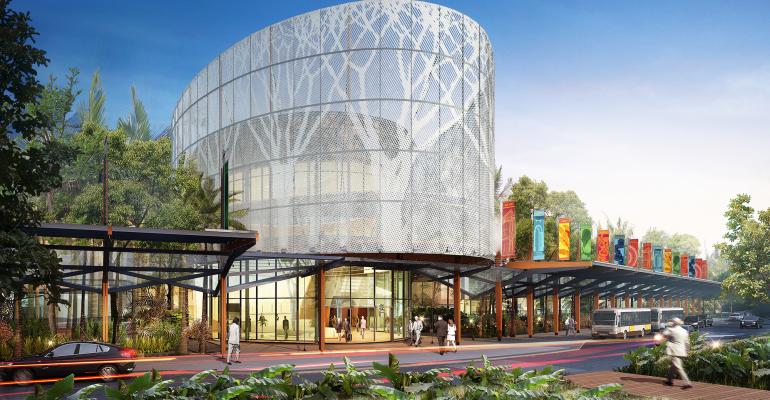“Costa Rica has everything, including hot and cold running surfing,” this comment was overheard at Daniel Oduber Quirós International Airport in Liberia, Costa Rica, and neatly sums up the country. The commenter, a surfer dude, was referring to Costa Rica’s amazing beaches on both sides of the continental divide, one bordering the (colder) Pacific Ocean, the other on the (warmer) Caribbean Sea. And, since we are talking about water, unlike many Central American countries, the tap water there is clean enough to drink. That’s not the only thing meeting professionals will love about Costa Rica.
A new, $30 million national conference center, Centro Nacional de Congresos y Convenciones is scheduled to open in February 2018 with state-of-the-art technology and an emphasis on sustainability. CNCC’s bioclimatic architecture will include the largest solar array of any building in the country, water recycling, and energy-saving features such as reflective ceilings and sunshades. The meeting and exhibit venue will hold up to 4,600 attendees in a total of 167,900 square feet on a 25-acre campus that will include shaded outdoor meeting space planted with native trees. CNCC is being built five miles from the Juan Santamaría International Airport and is around the same distance from downtown San José on the General Cañas Highway, which is currently being widened to accommodate increased traffic.
The convention center is the latest in a series of successful efforts on the part of the government to attract outside investment; the second largest industry after tourism is electronics and medical equipment. The educated workforce has helped make the country the Silicon Valley of Central America; Intel, Lucent, and Acer all have large plants and offices there. But Ticos, as Costa Ricans are known, are still devoted to living the pura vida. Literally translated as “pure life,” Costa Ricans use the phrase like the Hawaiian “Aloha;” it’s a greeting, a farewell, and a general expression meaning “all good” or “this is living.”
Costa Rica is less than five hours flying time from both New York and Los Angeles, and for Europeans the flight time is the same as traveling to Las Vegas or San Francisco. There are two international airports, Liberia in the northern Guanacaste area and Juan Santamaría in the capital San José, and they are served by 15 foreign airlines with more than 430 flights a week from international destinations. Costa Rica does not require a visa for Americans or members of the European Union and Russian Federation.
The country has a long history of tourism and sustainability. In 1948, President Jose Figueres Ferrer abolished the army and devoted the military budget to education, culture, and tourism. The government has also supported conservation efforts since the 1950s by imposing strict regulations on land and water use to preserve the extraordinary rain and cloud forests and limiting building along the coasts. The result of that decision is not just a pristine ecology and uncluttered beachfronts, but a highly educated population with a professional hospitality industry that is used to operating in a regulated environment. This is useful for meeting planners who need help from suppliers to document every food and lodging item down to the last tip.
Professionals planning an international meeting but who are mindful of their company’s carbon footprint will also appreciate that Costa Rica is working toward being carbon neutral by 2021. The government protects almost 30 percent of the Costa Rican landmass and 93 percent of the electricity used is generated from renewable sources such as wind, hydro electric, geothermal, and solar. As part of the C-Neutral program, visiting organizations who want to support sustainability can pay a voluntary “tax” calculated at $7.50 per ton of CO2e by the Fondo Nacional de Financiamiento Forestal. All the money raised is deposited with the Costa Rican Environmental Services Payment Program and is used for conservation efforts.
Take the pura vida approach to planning your next meeting, enjoy the advantages of a high-tech venue and then stay a couple of days to appreciate the biodiversity and beaches. Come for the convention center, stay for the sloths.





